A statistical study of the performance of our blog posts in series (like this one) versus stand-alone posts shows pretty conclusively that the former drive better site experiences.
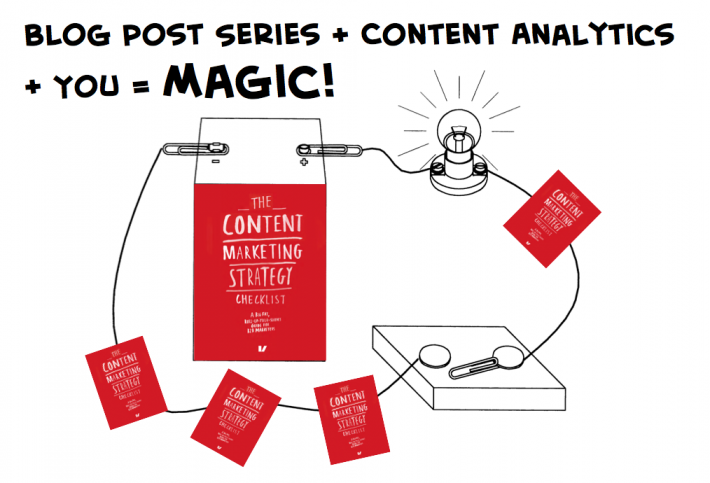
This post is the fifth in the Diary of a Content Pimp series (see parts 1, 2, 3 and 4), and the second in the content analytics series (see part 1 here).
This is appropriate as this post provides the results from our own study of whether posts in a series work harder for our website than their stand-alone blog post brethren. How meta.
The conclusion: Blog post series like this one (we’ll get into a tighter definition later) seem to be more profitable for Velocity Partners and its blog; they generally lead to longer site visits (measured in time duration and overall pages viewed) and conversions – form fill-outs for downloads of our premium content.
The Hypothesis
Each content analytics post starts with a hypothesis – an assumption about the performance of our content that we believe to be true, but which we want to test. This experiment’s hypothesis:
Posts that are connected into a series (that is, explicitly identified as a series, numbered and interlinking) will show better metrics in terms of site experience, such as pages per visit and duration of visit, and bottom line conversions.
The Experiment Design
In order to determine an uplift for series, I needed first to settle on a good definition of a “series”. A series is 4+ posts that all cover a similar topic, that are identified as a series (with a name for the series), that link to one another extensively and that appear in relatively quick succession.
For those more versed in content management, a series could be considered as just a more explicit version of a category or topic. The series is a familiar way of presenting a story over time, and building suspense. Heck, even the Victorians were serializing novels in a big way in the 1800s.
I was quickly able to identify three relatively recent series from the Velocity blog:
- The Open Robe series – Our behind-the-scenes study of the performance of Velocity’s own effort to promote and track the B2B Marketing Manifesto.
- The B2B Masters series – A series of video interviews published earlier this year, with John Watton of Expedia Affiliate Network and our Stan Woods.
- Diary of a content pimp – This series itself, which applies some of the same thinking of Open Robe to Velocity’s promotion and tracking of the B2B Content Marketing Strategy Checklist.
As the Open Robe series was particularly long (stretching to some 15 or 16 posts), I divided it into two separate series of four posts for the sake of the study: Open Robe 2, 3, 4 and 5; and Open Robe 6, 7, 8 and 9.
For each series, I set up a custom report in Google Analytics that would track the post’s performance as a landing page. For visitors whose visit started on that page, how many pages did they visit on average during the session, how long did the overall session last and what proportion downloaded our premium content (the eBooks).
To provide a control to measure any uplift (or depression) against, I randomly selected four posts that appeared at roughly the same time as the series against which it would be compared. I wanted to keep the timing similar, as my goal is to determine whether the interlinking, the naming and the serialization itself led visitors to have a better experience.
The Room for Error
Short of contacting every single person who landed on each of these pages and interrogating them about their behavior, there is no way to be 100% certain of our results.
Error can and will creep in. Here’s how:
- A high page per visit number isn’t necessarily a great site experience metric. For example, people addicted to a series may come religiously to read only the latest post in the series, in which case they will have only one page per visit (despite a great experience with the series). The same can be said of duration per visit.
- Three of the four series I’ve selected are all about promoting our eBooks – thus, they inherently drive conversions (it’s their raison d’etre). To say that a series of posts designed to push people towards conversion, actually does so, doesn’t necessarily speak to the performance of their being in a series.
- Four series, each of only four posts a piece, are a limited number from which to draw conclusive results. I would say that the results can only be considered “indicative” (which, for all blogging purposes, is probably good enough).
The Data
All of the results are collated into three tables, indicating the performance on the three key metrics: pages per visit, duration time and conversion percentage.
Each series is measured against the control, which is given the descriptor “Contemp” (which represents posts that appeared contemporaneous with the series in question).
The data for each series was averaged into a single site experience coefficient – to make the results neater and easier to read.
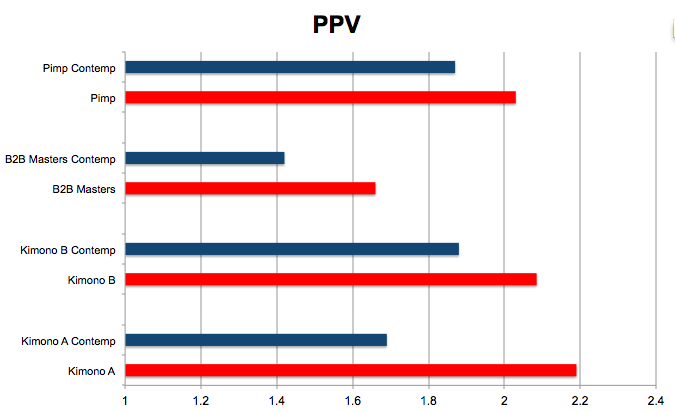
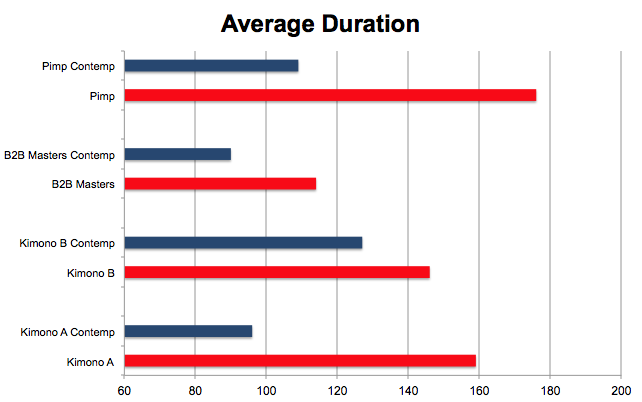
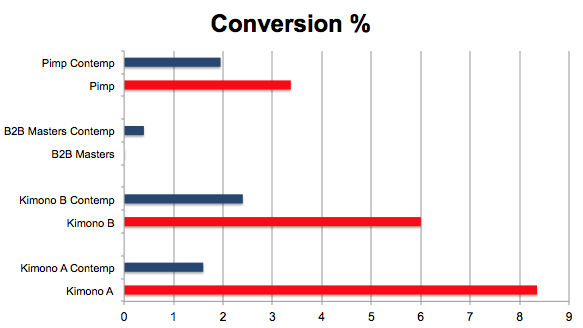
The Conclusions
Our indicative results show quite clearly that series provide an uplift in terms of pages per visit, visit duration and conversion. However (and this is a big however), the boosted conversion rates probably stem from the fact that the series itself was all about boosting conversion. The one series that was not explicitly about promoting an eBook actually showed a (slightly) lower conversion rate.
There may also be a sign that the longer a series, the better it performs according to these metrics, but – since that wasn’t a specific area of the study – it’s only a hunch given the data.
Suppositions as to why series lead to greater site experience?
- Readers love predictability. A series concentrates the output of a blog, and presents it for easy consumption, into a neat package.
- Readers like a feeling of progress. It’s a form of suspense, once they’re hooked. They will want to know what’s next in the series.
- Readers click on the links they see. It sounds silly, but simply pushing a bunch of links in front of people’s eyes has some effect.
If that wasn’t enough argument for producing content into explicit series, here’s a couple more good reasons: 1) Google’s bots generally respond to well interlinked sites with a high concentration on a given topic by boosting that site’s performance on searches for that topic, and 2) The process of producing the series will professionalize you and your business in the topic of the series (you’ll literally grow together with your audience).
So, summa summarum, don’t expect to see an end to Velocity’s series (Diary of a Content Pimp or Content Analytics) any time soon.
Other ‘Diary of a Content Pimp’ posts
1) The Kick-off – why we’re doing this
2) Goals, Metrics & Fears – sticking our collective necks out
3) The Promotion Plan – how we’re pimping the Checklist
4) Forms or No Forms – the upside and down

Enjoyed this article?
Take part in the discussion


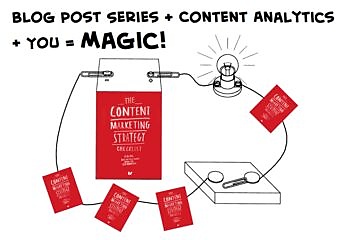





Comments
Ardath Albee August 22nd, 2012
Hi Ryan,
Thanks so much for sharing the “evidence” that series posts work. By extension, your reasoning in the three points you include about why is also applicable to a lead nurturing program that builds out a storyline over time (across buying stages). It’s a connection thing. Think about reading a novel. Readers usually put them down at a scene or chapter break. But they have no problem picking them back up again and continuing on with the story. The same concept applies here with a topical continuation.
The one point I’d make is that in your third bullet, you say that “…simply pushing a bunch of links in front of people’s eyes has some effect.” I’d disagree that a “bunch” of links does this. It’s the connection to the series or the extension of thought that makes those links successful.
Thanks for a great review…and series!
Ryan Skinner August 28th, 2012
Hi Ardath,
Great point. Onscreen real estate is one thing – context and meaning is another.
I’d love to see how series work in email campaigns for lead nurturing. That is, if you run a lead nurturing email campaign with monthly mailers that clearly are part of a series – how do open rates and CTR differ from non-series type email campaigns? As you suggest, I expect series would outperform standalone content.